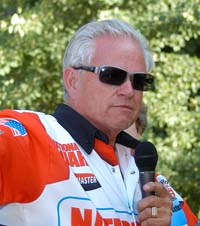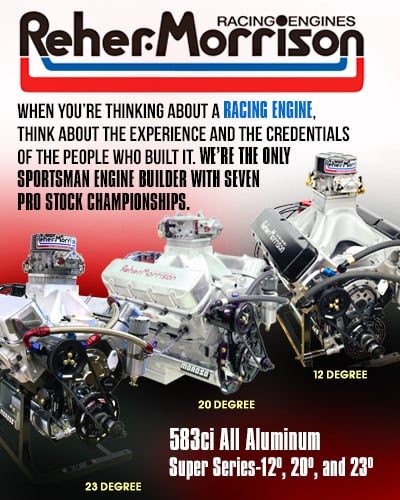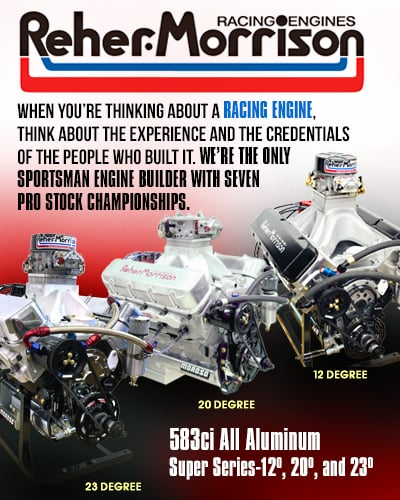TRACTION CONTROL DEBATE REACHES ADRL CENTER STAGE
Wed, 2009-09-16 08:02
 Traction control could be living on borrowed time in a series that was introduced on the premise of outlaw racing with no rules.
Traction control could be living on borrowed time in a series that was introduced on the premise of outlaw racing with no rules.The ADRL, fearing their volatile doorslammer program could become automated, is pondering a ban on the use of traction control. And, according to a high-ranking ADRL official, a decision could be made as early as next week.
“We issued a questionnaire to the racers last week,” Bubba Corzine, ADRL Vice President of Competition said on Tuesday afternoon. “We wanted to get their thoughts on the topic of traction control. We are considering it and I believe it would be a tough rule to police if we outlawed it.
Right now we are just trying to gather data to help us make a better decision.”
ADRL Investigates Whether The Device Should Be Legal Or Not …

Bubba Corzine, ADRL's Competition Director, confirmed that the sanctioning body will make a decision by next week as to whether traction control will be legal in the future. Skeptics believe the ADRL is incapable of policing traction control should they outlaw the device.
The ADRL, fearing their volatile doorslammer program could become automated, is pondering a ban on the use of traction control. And, according to a high-ranking ADRL official, a decision could be made as early as next week.
“We issued a questionnaire to the racers last week,” Bubba Corzine, ADRL Vice President of Competition, said on Tuesday afternoon. “We wanted to get their thoughts on the topic of traction control. We are considering it and I believe it would be a tough rule to police if we outlawed it.
Right now we are just trying to gather data to help us make a better decision.”
Earlier in the summer, the ADRL.us website, touted at least one team’s use of traction control and proclaimed that it was legal for competition in their series. Reportedly, upper management at the ADRL was approached by two teams regarding the future of traction control and while each had a unit on their cars, both were disconnected.
These conversations were reportedly responsible for the ADRL interest in whether they should
outlaw the practice early in the game.
Corzine confirmed that he has spoken to at least one traction control manufacturer and was told if
a racer was willing to spend the money, they could gain a car that essentially runs itself and greatly decreases the margin for error. That potential is what has the ADRL questioning the use of traction control devices in the future.
“We just want to be proactive instead of reactive,” Corzine admitted. “If it becomes apparent that we need to make a decision, we will. I’m not looking to do that but I’m not ruling it out either. We’ve always done what the racer wants to do.”
That was the purpose of distributing the questionnaire during the driver’s meeting at the ADRL Dragstock event in Rockingham, N.C., this past weekend.
“We just want to get information so we aren’t put in the same position as other sanctioning bodies have been put in at one time or another,” Corzine explained. “Two years from now I don’t want to be second-guessing a decision that we should have made now should the situation gets out of control.”
And for Corzine, putting rules on cars that in the past had very little boundaries can become a situation similar to eating a bag of chips. You just can’t eat one, or in this case one rule usually spawns another and so on.
“It’s a problem to stop putting on rules from that point,” confirmed Corzine. “We understand that reality very well.”
Corzine says until he can review the returned questionnaires, he cannot begin to determine how many cars in ADRL are using traction control.
Shannon Davis, of Davis Technologies, a leading supplier of traction control devices, has a number.
”Data is huge and we have over 100 cars to pull data from in drag racing,” Davis said in an interview last Saturday. “We are learning quicker from the data. The stuff we are doing is 800 times faster than what we had in 2008.”
That kind of response time can come in handy for a driver who suddenly loses control or suffers engine failure and puts oil under the rear tires.
For Davis, it is important the teams get that improved reaction and told CompetitionPlus.com that he will upgrade the 2008 systems for teams to the current version for free. Units prior to 2008, he’ll upgrade for a reasonable price.
Regardless of what the ADRL does, drag racing school instructor Roy Hill says he will use the units in his school for safety purposes. All of his cars now carry Davis Technologies units.
“We’ve been testing it and whether it’s a bracket car on a slick track or the high-horsepower school Pro Stockers or the Pro Mod car. I’m using them for safety purposes. Traction control has been outlawed in some places but for me, the safety part of it is what’s most important. We can benefit from having it out here.”
Davis started experimenting with traction control in oval track applications and began working his way into drag racing about two years ago. Sponsorship involvement with Mike Janis is what put the traction control issue on the big stage of awareness. He's been working with traction control applications since 1997 and began working his way into drag racing about six years ago.
Davis confirmed he has customers in every ADRL class except for Extreme Pro Stock, where the use of traction control is prohibited.
“When you look at it, if it isn’t spinning the tires, you’ve got better control of the car,” Davis said. “When you have better control of the car it is safer.”
Davis admits his company never initially pushed traction control with the objective being safety but rather consistency. Safety has since increased in importance.
“When you hear the stories of racers like Joey Martin, who installed a unit on Friday and then broke an oil line on Saturday and was able to gather the car back in without a scratch, you could look at the computer data and see the traction control working as hard as it could work,” Davis said. “Can’t say whether it was the sole reason he saved the car, but it didn’t hurt it either.”
Davis confirmed that his units will kick in as quickly as three inches into slippage.
The safety aspect of retaining traction control could work in favor of its advocates.
“If it’s making the cars safer then we need to have it,” Corzine said.
And, that’s why Corzine doesn’t want to be quick to rush to judgment on this issue.
Advertisement
Categories:



































